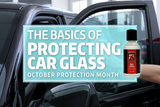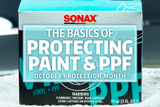The Ultimate Guide to Compounds and Polishes for a Flawless Finish: Part 1 of 2
Hey there, car lovers!
You’ve spent hours washing and waxing your car, but in the right light, you still see them—pesky swirl marks, light scratches, and dull spots that keep your paint from reaching its full potential. While a good wash and wax are essential for maintenance, they can’t fix what's already there.
To truly restore your vehicle's shine and correct paint defects, you need to go a step further into the world of paint correction. And the two most powerful tools for the job are compounds and polishes.
So, what exactly are they, and why do you need both?
Compounds vs. Polishes: The Difference is in the Cut
Think of your car's clear coat—the protective top layer of paint—like a sheet of glass. Over time, that glass gets tiny scratches, scrapes, and blemishes. Compounds and polishes are abrasives designed to level out that surface, effectively "sanding" down the imperfections to reveal a smooth, flawless layer underneath.
- Compounds: These are the heavy hitters. Compounds contain larger, more aggressive abrasives designed to remove deeper defects like heavy swirl marks, light scratches, oxidation, and water spots. Compounds come in varying levels of abrasiveness. They are your first line of defense for a heavily damaged finish. Because they are more aggressive, they will leave a slightly hazy finish that needs to be refined.
- Polishes: These are the refiners. Polishes contain much finer abrasives that are designed to remove light swirls and refine the finish left behind by a compound. They are what give your paint that deep, wet-looking gloss. Many people use a finishing polish as a standalone step to remove very light defects and enhance gloss.
The goal is to use the least aggressive product to achieve the shine you desire. For many cars, a good polish is all you need. But for a vehicle with noticeable defects, you’ll want to start with a compound and then follow up with a polish.
The Basic Steps to a Perfect Shine
Ready to give it a try? Here's the general process for paint correction:
- Prep is Everything: Start with a thoroughly washed and decontaminated surface. Use a decontamination spray and a clay bar to remove all bonded contaminants. You never want to rub dirt or debris into your paint while you're working.
- Compound the Imperfections: Apply a small amount of compound to your polishing pad and work on a small section of your car, no bigger than two feet by two feet. Using a dual-action or rotary polisher, gradually work the product into the paint until the defects are gone. Remove leftover compound dust with a microfiber polishing towel.
- Refine with a Polish: Switch to a softer polishing pad and a dedicated polish. Work the polish over the same section you just compounded. Remove any excess product with a clean microfiber polishing towel. This step will remove any haze from the compound and leave you with a brilliant, high-gloss finish.
- Protect Your Work: Once you've completed the entire vehicle, be sure to apply a wax, sealant, or ceramic coating to protect your newly corrected paint from future damage.
By understanding the role of compounds and polishes, you're on your way to achieving a professional-level finish right in your own garage. It’s the ultimate way to bring your car’s paint back to life!
Ready to get started? Head over to Autogeek.net to explore our wide selection of compounds and polishes!
Explore Popular Articles
-
New Video Alert: How To Clean Car Windows Like A Pro—Get Streak-Free Glass, Guaranteed!
8th Oct 2025 @ 9:20 AMHello again, detailing warriors and car care enthusiasts! You've spent hours perfecting your paint,
-
Protect Your Ride: Autogeek’s Guide to Automotive Glass Care Protection
8th Oct 2025 @ 9:19 AMYour car's windows and windshield are critical to safe driving and the overall appearance of your ve
-
Protect Your Ride: Car Paint Protection and PPF
1st Oct 2025 @ 1:24 PMYour car is more than just a mode of transportation—it's an investment and a source of pride. Keepin




